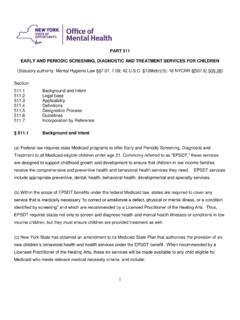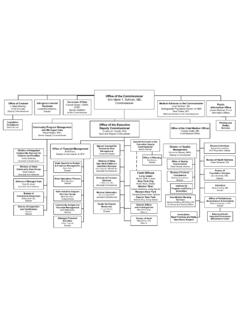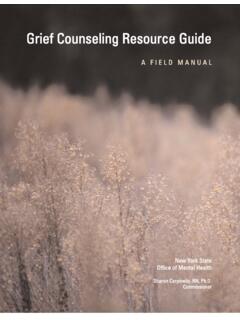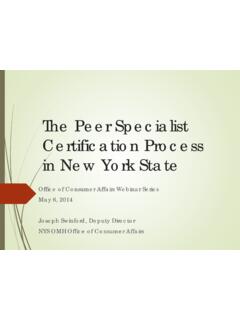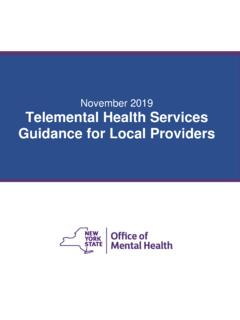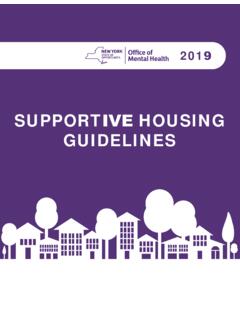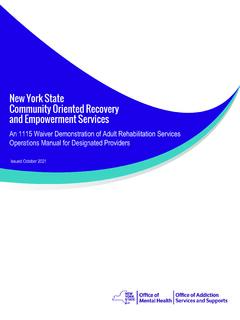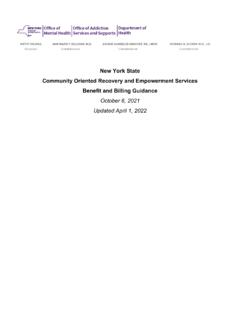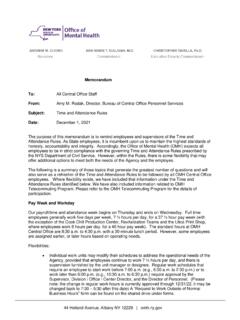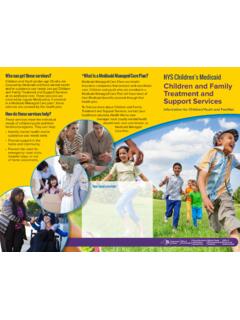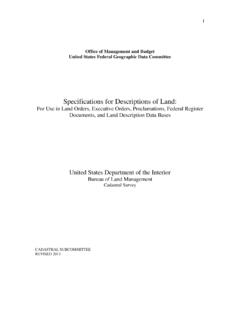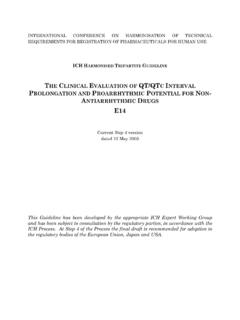Transcription of New York State: Health and Recovery Plan (HARP) Adult ...
1 New York State: Health and Recovery Plan (HARP). Adult Behavioral Health Home and Community Based Services (BH HCBS). Provider Manual New York State is reissuing the Adult Behavioral Health Home and Community Based Services (BH. HCBS) Provider Manual that is used as a basis for the BH HCBS designation process. Please note this manual only includes Adult BH HCBS available to eligible individuals in Health and Recovery Plans (HARP) or HARP-eligible in HIV Special Needs Plans (SNPs). The BH HCBS included in this manual have been approved by CMS to be included in the HARP benefit package. The BH HCBS manual describes the basic requirements for any entity designated to provide BH HCBS. within New York's public behavioral Health system. These entities may include: Behavioral Health contracted and non-contracted providers, including those that provide rehabilitation, employment, community-based treatment, peer support, and crisis services.
2 State entities providing behavioral Health services, including mental Health and/or substance use disorder services; or other organizations or clinicians that meet criteria. Hospitals providing specialized behavioral Health services. Licensed/ Certified residential, inpatient and organizations providing mental Health and/or substance use disorder clinical services. Programs currently providing outreach, peer, vocational, or rehabilitative services to individuals with substance use disorders (SUD) funded through Alternatives to Incarceration, Ryan White Federal funding, or funding from Department of Health and Mental Hygiene, NYC Department of Health , or the AIDS Institute. The BH HCBS Manual includes information regarding services allowable and reimbursable as approved by CMS. This information includes service definitions and service requirements reflective of documents developed in accordance with Medicaid policies and protocols and submitted for approval.
3 There is a separate billing manual outlining reimbursement rates and billing codes. Specifically, the BH HCBS. Manual outlines the following: 1. Services Definitions & Descriptions 2. Provider Qualifications 3. Eligibility Criteria 4. Limitations/Exclusions 5. Allowed Modes of Delivery 6. Additional Service Criteria 7. Practitioner credentials for service provision Page 1 of 22. Reissued 02/17/2022. I. Introduction The Centers for Medicare and Medicaid Services (CMS) has authorized various BH HCBS under their Medicaid waiver authority. BH HCBS were initially established to keep individuals out of hospitals, nursing homes or other institutions. Recipients had to be evaluated and assessed to meet an institutional level of care, , they could be admitted to an institution if not for the availability of the BH HCBS waiver program. Section 1915i of the Social Security Act was established as part of the Deficit Reduction Act of 2005.
4 1915i afforded States the opportunity to provide HCBS under the Medicaid State Plan without the requirement that Medicaid members need to meet the institutional level of care as they do in a 1915(c). HCBS Waiver. The intent is to allow and encourage states to use the flexibility of HCBS to develop a range of community-based supports, rehabilitation, and treatment services with effective oversight to assure quality. These services are designed to allow individuals to gain the motivation, functional skills, and personal improvement to be fully integrated into communities. The 1915i option acknowledges that even though people with disabilities may not require an institutional level of care ( , hospital, nursing home) they may still be isolated and not fully integrated into society. This isolation and lack of integration may have been perpetuated by approaches to service delivery which cluster people with disabilities, and don't allow for flexible, individualized services or services which promote skill development and community supports to overcome the effects of certain disabilities or functional deficits, motivation, and empowerment.
5 CMS allows states to include the flexibility of 1915i state plan services in 1115 Research and Demonstration Waivers. New York State has chosen to include 1915i-like BH HCBS in its 1115 Waiver amendment for behavioral Health . The inclusion of these BH HCBS will give NYS managed care provider networks and most importantly, enrollees in managed care, a new range of BH HCBS in their benefit package. These services are designed to help overcome the cognitive and functional effects of behavioral Health disorders and help individuals with behavioral Health conditions to live their lives fully integrated into all aspects of their community. The addition of these services to the benefit package will also assist NYS to meet the requirements of the Americans with Disabilities Act and the Olmstead Law. The primary goal is to create a supportive and empowering environment for people with behavioral Health conditions to live productive lives within our communities.
6 CMS also requires state oversight to determine that the assessment is comprehensive, the planning process is person-centered and addresses services and support needs in a manner that reflects individual preferences and goals, the services were actually provided, and the person is assessed at least annually or when there is a change in condition ( , loss of housing, inpatient admission, etc.) to appropriately reflect service needs. CMS also requires assurances which the state, managed care plans and providers must monitor and report on to assure people receiving BH HCBS are receiving the appropriate services. On March 17, 2014 CMS issued the Final HCBS Rule that established, upon other provisions, conformity across HCBS authorities for person-centered planning and allowable settings. The rule states that HCBS. can only be provided in settings which are considered integrated community settings.
7 New York State is reviewing these rules to determine how this will be addressed in certain housing, residential and day programs. A person receiving HCBS must be assessed using a validated comprehensive assessment tool to determine their treatment, rehabilitation, and support needs. A comprehensive, person centered plan of care is then developed, and the person is then connected to appropriate services. The care plan must be developed in a conflict free manner, meaning the person conducting the assessment and developing the plan of care cannot direct referrals for service only to their agency or network. The person must have Page 2 of 22. Reissued 02/17/2022. choice among available providers. New York State has CMS approved safeguards to ensure that all conflict free requirements for the HCBS HARP benefit are met. The provider manual describes these services in detail and the requirements for providers' participation.
8 We look forward to working with managed care plans and provider networks to transform our system of care to one that supports rehabilitation and Recovery from behavioral Health conditions. II. Values/Core Principles The past 30 years have seen a transformation of the public behavioral Health system. The State-operated Adult psychiatric hospital census has declined from over 20,000 to under 2,900. Access to outpatient treatment, community supports, rehabilitation, and inpatient psychiatric services at general hospitals have expanded. More than 38,000 units of state supported community housing for people living with mental illness have been developed. These community-based resources have created a safety net which has helped the mental Health system to evolve from a primarily hospital focused system to one of community support. The emergence of the peer Recovery and empowerment movement in the 1990s has stimulated the shift in focus from support to Recovery .
9 The legal system's expansion of civil rights to include people with mental illness, as part of Olmstead Legislation and Americans with Disabilities Act, has begun to move policy from the concept of least restrictive setting to full community inclusion. In 2008, New York State initiated detox reform that reduced incentives for unnecessary hospital detox and began the process of building community and ambulatory access to withdrawal symptom management for SUD patients who do not require a hospital level of care for safely discontinuing the use of substances. OASAS initiated ancillary withdrawal services to allow for the management of mild to moderate withdrawal symptoms in outpatient and inpatient settings. The goal will include access to medically supervised withdrawal management in all levels of care for symptom management where there is very low risk of medical complications of withdrawal .
10 SUD individuals will be able to access treatment in the lowest level of care necessary to support long-term Recovery . The development of Health and Recovery Plans (HARPs) is intended to promote significant improvements in the Behavioral Health System as we move into a Recovery -based Managed Care delivery model. A Recovery model of care emphasizes and supports a person's potential for Recovery by optimizing quality of life and reducing symptoms of mental illness and substance use disorders through empowerment, choice, treatment, educational, employment, housing, and Health and well-being goals. Recovery is generally seen in this approach as a personal journey rather than a set outcome, and one that may involve developing hope, a secure base and sense of self, supportive relationships, self- direction, social inclusion, and coping skills.
